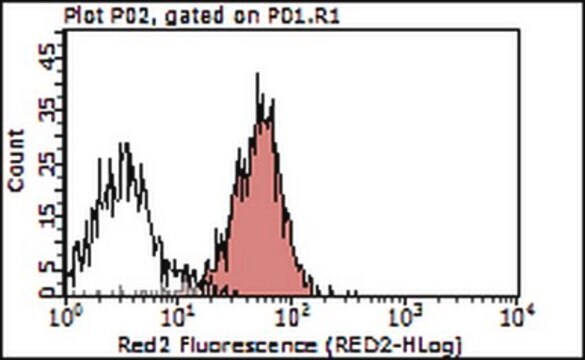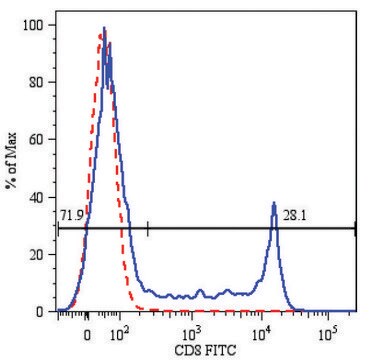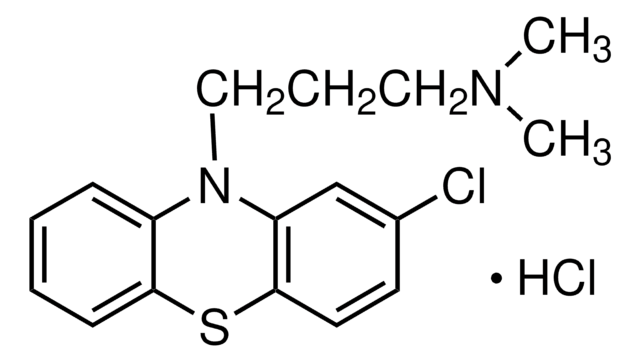추천 제품
생물학적 소스
human
재조합
expressed in Hi-5 Insect cells
분석
≥97% (HPLC)
≥97% (SDS-PAGE)
양식
lyophilized
분자량
15.5-25.0 kDa
포장
pkg of 10 μg
기술
cell culture | mammalian: suitable
불순물
<0.1 EU/μg endotoxin, tested
색상
white to off-white
UniProt 수납 번호
배송 상태
wet ice
저장 온도
−20°C
유전자 정보
human ... TNFSF4(7292)
일반 설명
OX40L or tumor necrosis factor superfamily member 4 (TNFSF4), which is a member of the TNF superfamily of structurally related proteins, exists primarily as a type II membrane bound, non-covalently linked homotrimeric protein. This cytokine is expressed on antigen presenting cells (APCs), such as dendritic cells and activated B-cells, and also on various other cells such as vascular endothelial cells, mast cells, and natural killer cells. It has a 23 amino acid cytoplasmic tail and a 133 amino acid extracellular domain. The gene encoding this protein is localized on human chromosome 1q25 and has three exons. Recombinant OX40L is a glycosylated 133 amino acid protein corresponding to the extracellular TNF homologous domain of the full length transmembrane protein. It migrates with an apparent molecular mass of 15.5-25kDa on SDS-PAGE.
생화학적/생리학적 작용
OX40L signals specifically through the OX40 receptor, which is expressed predominantly on CD4+T cells but also on certain activated CD8+T cells. OX40/OX40L functions as a costimulatory signal, which is required for a productive interaction between antigen presenting cells and their target T-cells. It enhances cell proliferation and survival, and increases expression of regulated on activation, normal T cell expressed and secreted (RANTES) or chemokine ligand 5 (CCL5), interleukins-2 and -3, and interferon-γ (IFNγ). OX40/OX40L signaling plays an important role in immuno-regulatory communication and immune-tolerance. Polymorphisms in the TNFSF4 gene have been associated with autoimmune thyroid diseases (AITDs), rheumatoid arthritis (RA), systemic lupus erythematosus (SLE) and systemic sclerosis (SSc).
서열
QVSHRYPRIQ SIKVQFTEYK KEKGFILTSQ KEDEIMKVQN NSVIINCDGF YLISLKGYFS QEVNISLHYQ KDEEPLFQLK KVRSVNSLMV ASLTYKDKVY LNVTTDNTSL DDFHVNGGEL ILIHQNPGEF CVL
물리적 형태
Lyophilized from 10 mM Tris pH 8.5.
재구성
Centrifuge the vial prior to opening. Reconstitute in water to a concentration of 0.1-1.0 mg/ml. Do not vortex. This solution can be stored at 2-8°C for up to 1 week. For extended storage, it is recommended to further dilute in a buffer containing a carrier protein (example 0.1% BSA) and store in working aliquots at -20°C to -80°C.
Storage Class Code
11 - Combustible Solids
WGK
WGK 3
Flash Point (°F)
Not applicable
Flash Point (°C)
Not applicable
가장 최신 버전 중 하나를 선택하세요:
A diametric role for OX40 in the response of effector/memory CD4+ T cells and regulatory T cells to alloantigen
Gillain Kinnear
Journal of Immunology, 191(3), 1465-1475 (2013)
Control of Immunity by the TNFR-Related Molecule OX40 (CD134)
Michael Croft
Annual Review of Immunology, 28, 57-78 (2010)
TNFSF4 Gene Variations Are Related to Early-Onset Autoimmune Thyroid Diseases and Hypothyroidism of Hashimoto?s Thyroiditis
Rong-Hua Song
International Journal of Molecular Sciences, 17(8), 1369-1369 (2016)
Deborah S Cunninghame Graham et al.
Nature genetics, 40(1), 83-89 (2007-12-07)
Systemic lupus erythematosus (SLE) is a multisystem complex autoimmune disease of uncertain etiology (OMIM 152700). Over recent years a genetic component to SLE susceptibility has been established. Recent successes with association studies in SLE have identified genes including IRF5 (refs.
Qigui Yu et al.
Journal of immunology (Baltimore, Md. : 1950), 176(4), 2486-2495 (2006-02-04)
We have previously shown that CD4(+) T cells are required to optimally expand viral-specific memory CD8(+) CTL responses using a human dendritic cell-T cell-based coculture system. OX40 (CD134), a 50-kDa transmembrane protein of the TNFR family, is expressed primarily on
자사의 과학자팀은 생명 과학, 재료 과학, 화학 합성, 크로마토그래피, 분석 및 기타 많은 영역을 포함한 모든 과학 분야에 경험이 있습니다..
고객지원팀으로 연락바랍니다.





